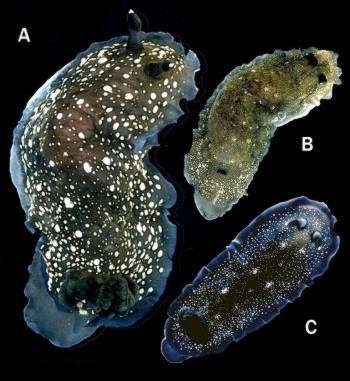
Dendrodoris nigra
(Stimpson, 1855)
Order: NUDIBRANCHIA
Suborder: DORIDINA
Family: Dendrodorididae
DISTRIBUTION
Tropical to warm temperate Indo-west Pacific
PHOTO
UPPER RIGHT:
A. 70mm long, North Coast, New South Wales, Australia, March 1982, (C132971).
B. 50-70mm long, Long Reef, Sydney, New South Wales (C114835).
C. 40mm long, Noumea, New Caledonia, October 1988, (C156601) PHOTOS: Bill Rudman.
SEE MORE PHOTOS BELOW
RELATED TOPIC
An extremely common intertidal dorid often found quite high on the shore. Although, as its name implies, it is often black, there are many colour forms of this species, often associated with growth, many specimens being pink or orange when juvenile but black when adult. Black adults often have clusters of white spots on the mantle, and sometimes there can be a marginal or submarginal red or pink mantle border. Another species, D. fumata, has similar colour variation and the two species are often confused. Risbec's named many species from New Caledonia which are merely colour forms of these two species, and one species, D. communis Risbec, 1928, would appear to be a combination of both species. Pease (1871) also gave different names (D. debilis, D. sordida, D. rubrilineata), to colour forms of this species from Tahiti, and Bergh's species, D. affinis, again from Tahiti, is also a synonym. Most external differences between D. nigra and D. fumata are comparative, for example, D. nigra is more elongate when crawling than D. fumata. The position and nature of the gills would appear to be characteristic. In D. nigra the gills are relatively numerous and form a compact circle around the anus at the extreme posterior end of the dorsum. In D. fumata there are only 5 or 6 gills which are relatively large and openly branched. Unlike D. nigra they are situated in the dorsal midline some distance from the extreme posterior end of the body. One internal character clearly separates the two species. As Edmunds noted (1971), Gohar & Soliman's excellent account (1967a) of the anatomy of D. fumata, and his own investigation of D. nigra showed that in D. nigra there is an accessory gland at the genital opening which is absent in D. fumata. It is not possible to identify all earlier names given to these species for both species cover most colour forms.
When white spots are present they are of two different kinds. Some spots are simply pigment spots on the skin while others are small white glands producing a milky acidic secretion. Usually the glandular spots are aggregated into clusters as in Fig B.
PHOTO:
D. 36mm long, Koumac, New Caledonia, October 1993, (C200523).
E. 15mm long juvenile, Noumea, New Caledonia, October 1988, (C156675)
F.10mm long juvenile, Noumea, New Caledonia, October 1988, (C156595).
G. 10mm long juvenile, North Coast, New South Wales, March 1982, (C132943).
H. 9mm long juvenile, Two Fold Bay, New South Wales, March 1986, (C149571).
I. 36mm long, Koumac, New Caledonia, October 1993, (C200525). PHOTOS: BILL RUDMAN.
Reference:
• Stimpson, W. (1855). Descriptions of some of the new marine Invertebrata from the Japanese and Chinese Seas. Proceedings of the Academy of Natural Sciences of Philadelphia, 7(10): 375-384.
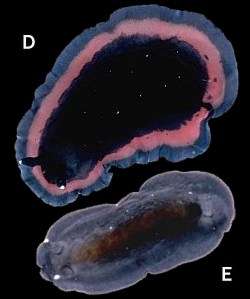
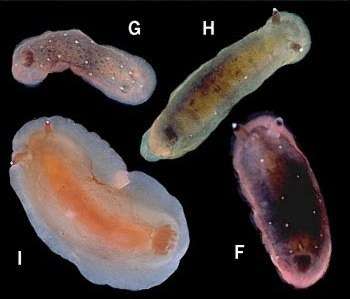
Rudman, W.B., 1999 (August 16) Dendrodoris nigra (Stimpson, 1855). [In] Sea Slug Forum. Australian Museum, Sydney. Available from http://www.seaslugforum.net/find/dendnigr
Related messages
Re: Dendrodoris nigra - hitchhiking again
March 19, 2010
From: Kevin A Mitchell
Concerning message #9034:
Well Guys,
I have just set-up my small marine aquarium with saltwater and live rock from a local store here in the UK. The lighting, filtration, aeration and heating element have only been switched on for 8 hours and my "Doris" (I'll assume she's female and hope that he's not offended if male) - has already emerged.
There is nothing other than the marine sand base and 15Kg of live rock in the tank.... Is there a record for the speediest sighting ever ? How long can I expect her to stay around (alive) without adding anything such as coral to the tank and are there any fish that would consider her as food ?
Best wishes and thanks.
Kev Mitchell
Hazlemere, near High Wycombe, England.
kev.a.mitch@gmail.com
Kevin Mitchell, 2010 (Mar 19) Re: Dendrodoris nigra - hitchhiking again. [Message in] Sea Slug Forum. Australian Museum, Sydney. Available from http://www.seaslugforum.net/find/23349Dear Kev,
I am not sure if anyone has studied the longevity of Dendrodoris nigra but many species of nudibranch live for less than a year. In your case we don't even know if there is any of its sponge food living on the 'live rock' - so I guess every day is a day longer than we could predict
Best wishes,
Bill Rudman
Re: Dendrodoris nigra from New Zealand
October 27, 2009
From: Bill Rudman
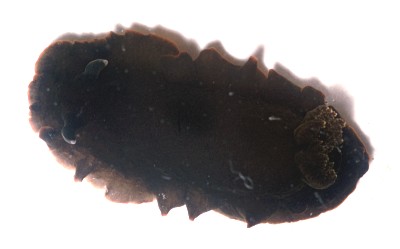
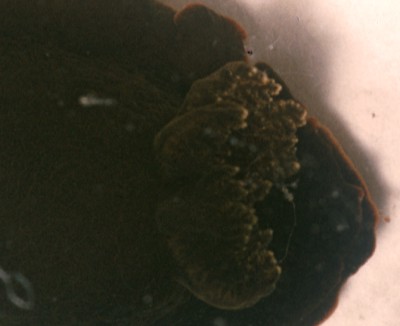
In response to Graham Bould's message [#22590] here is a photo of Dendrodoris nigra from New Zealand showing the typical gill circlet in this species. The photo has been kindly provided by Dr M.C. Miller
Locality: Takapuna, North Shore, Auckland, New Zealand. 10 July 1960. Intertidal. Photo: M.C.Miller
Best wishes
Bill Rudman
Dendrodoris nigra? from New Zealand
October 27, 2009
From: Graham Bould
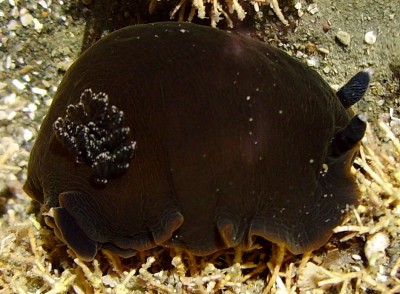
Photo of what I think is Dendrodoris nigra attached. This species is fairly common on the Whangaparaoa coast, both under rocks & out in the open in rock pools. However there don't seem to be any colour variation - they are all the same dark brown to black.
Locality: Rocks, Low tide level, Whangaparaoa Peninsula, east coast, northern New Zealand, Pacific, 22 July 2009, In rock pools near low tide. Length: 30 mm. Photographer: Graham Bould.
Graham Bould
graham@grahambould.net
Bould, G., 2009 (Oct 27) Dendrodoris nigra? from New Zealand. [Message in] Sea Slug Forum. Australian Museum, Sydney. Available from http://www.seaslugforum.net/find/22590Dear Graham,
From my memories of collecting in New Zealand, Dendrodoris nigra is usually this colour there, although there can be a more distinct red border to the mantle. Although D. nigra is the only 'black' species reported from New Zealand, I wouldn't be surprised if the very similarly coloured D. fumata is also present at times. As I discuss on the species' Fact Sheets, one very obvious difference is the shape of the gills - in D. nigra there are many short gills arranged in a goblet-shaped ring around the anus, while in D. fumata there are about 5 large feathery gills which extend out almost to the mantle edge. Their egg masses are also quite different.
In a separate message [#22722 ] I am posting a good photo from New Zealand showing the typical gill shape of D. nigra.
Best wishes,
Bill Rudman
Re: Big Black Slug in my aquarium
December 4, 2007
From: Shelly Craigie
Concerning message #21231:
Thank you, I am in Kelowna, British Columbia, Canada. I suspect the slug found it's way into my reef tank via some live rock. I put him back in and have seen him 2 more times.
Shelly Craigie
jim-shel@shaw.ca
Craigie, S., 2007 (Dec 4) Re: Big Black Slug in my aquarium. [Message in] Sea Slug Forum. Australian Museum, Sydney. Available from http://www.seaslugforum.net/find/21250Dear Shelly,
Glad to help. Unfortunately I haven't time to answer all the aquarium queries I get, but as most refer to the same 6 or so animals I try and find time to include a few every now and then
Best wishes,
Bill Rudman
Re: Orange form of Dendrodoris nigra from Reunion
December 4, 2007
From: Hugues Flodrops
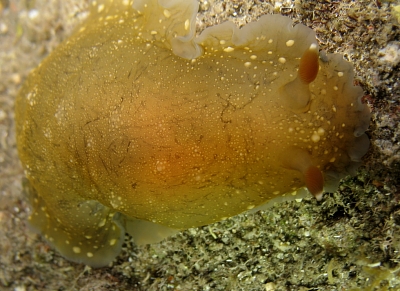
Concerning message #19586:
Dear Bill and Philibert,
Here is a new specimen from Reunion Island. It's size is about 45-50 mm. Like adults, it have clusters of white spots. It is a new variant orange-yellow form from Reunion of Dendrodoris nigra.
Locality: Etang-Salé, 2 metres, Reunion Island, Indian Ocean, 28 November 2007, Night. Length: 45-50 mm. Photographer: Hugues Flodrops.
Regards.
Hugues.
hugues.flodrops@wanadoo.fr
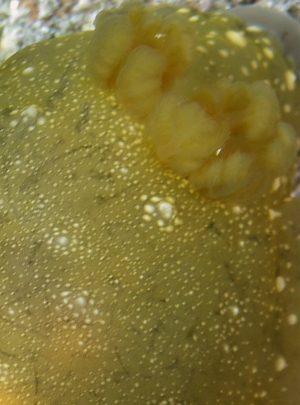
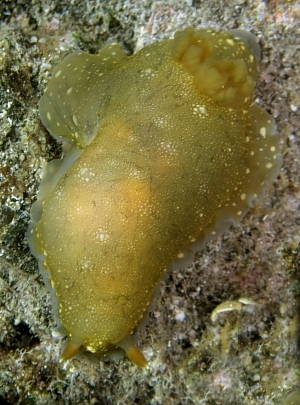
Dear Hugues,
I think this is better described as an 'albino' form or one lacking in black pigment rather than an orange-yellow form. This form with the large white glandular spots surrounded by a ring of smaller spots usually has a dense black background colour. For some reason the pigment is absent in this animal and th yellowish colour is from the viscera showing through the body wall and mantle
Best wishes,
Bill Rudman
Big Black Slug in my aquarium
December 3, 2007
From: Shelly Craigie
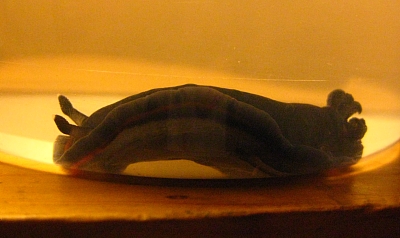
Hello,
I found this slug in my reef tank yesterday. It's the first time I have seen it and I have 'lost' 2 fish recently. It has a grabby hand like thing on it's butt. It's black with a purple rim around it. It also has 2 horns. Do you know what it is?
Locality: Fish tank. Length: 2 inches long . Photographer: Shelly Craigie .
Shelly Craigie
jim-shel@shaw.ca
Craigie, S., 2007 (Dec 3) Big Black Slug in my aquarium. [Message in] Sea Slug Forum. Australian Museum, Sydney. Available from http://www.seaslugforum.net/find/21231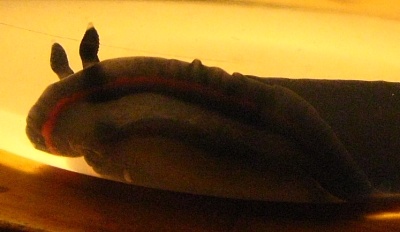
Dear Shelly,
Although you didnt give me any indication where in the world your slug may have come from I am pretty sure this is Dendrodoris nigra which is found in the tropical Pacific and Indian Oceans.
The general shape of the animal, the arrangement of the gills [which you describe as the 'grabby hand like thing'], and the red band around the mantle are all characteristic of that species.
Have a look at the species Fact Sheet for more information. The two 'horns' are its rhinophores - which are specialised tentacles used to smell its food. You mention losing 2 fish recently. Dont blame the nudibranch - or its 'grabby hand like thing' - this nusibranch only eats sponges.
Best wishes,
Bill Rudman
Dendrodoris nigra from the Seychelles Ids
August 25, 2007
From: David Barnes
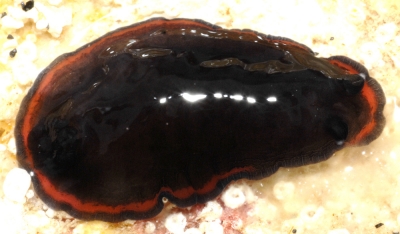
This black sea slug was found on the lower shore at Silhouette Is, Seychelles and if anyone knows what it is, I would be very pleased to know. We do not have the specimen - photos only.
Locality: Silhouette Is, Intertidal, Seychelles, Indian Ocean, August 2007, Rocks and sand. Length: ~2 cm. Photographer: Richard Barnes.
Richard Barnes
dkab@bas.ac.uk
Barnes D.K.A., 2007 (Aug 25) Dendrodoris nigra from the Seychelles Ids. [Message in] Sea Slug Forum. Australian Museum, Sydney. Available from http://www.seaslugforum.net/find/20537Dear Dave,
This is one of the colour forms of Dendrodoris nigra.
Best wishes,
Bill Rudman
Dendrodoris nigra colour variation from Reunion Island ?
May 15, 2007
From: Philibert Bidgrain
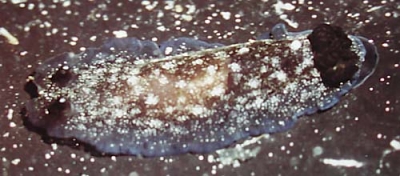
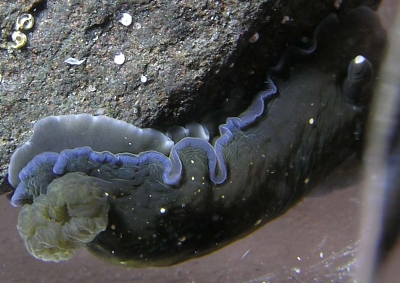
Dear Bill,
Reunion Island seaslugs
This species is relatively frequent in our island and isvery variable in colour. Reunion Island, Indian Ocean, Intertidal rocky coast
I send you different specimens. I think they are all Dendrodoris nigra....
In specimen 2 do you think that the more important white tips corresponded to milky acidic secretion?
What's your opinion about this identification?
Philibert Bidgrain
http://vieoceane.free.fr/runseaslug/indexslug.htm
pbidgrain@yahoo.fr
Bidgrain, P., 2007 (May 15) Dendrodoris nigra colour variation from Reunion Island ?. [Message in] Sea Slug Forum. Australian Museum, Sydney. Available from http://www.seaslugforum.net/find/19586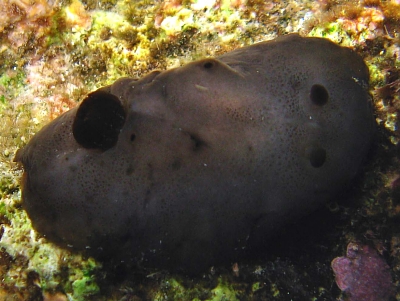
Dear Philibert,
The upper two animals are D. nigra and the white spots represent regions where there are small single-celled glands which exude a white secretion.
The lower animal has a cup-shaped gill circle somewhat reminiscent of D. nigra, but in this animal the gills are proportionally much smaller. This is a quiet unrelated animal, Actinocyclus verrucosus. It has a much tougher, almost leathery mantle, and scattered patched of small raised black spots.
Best wishes,
Bill Rudman
Dendrodoris nigra & eggs from Lord Howe Is.
February 25, 2004
From: Ian Hutton
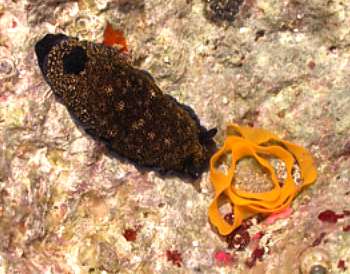
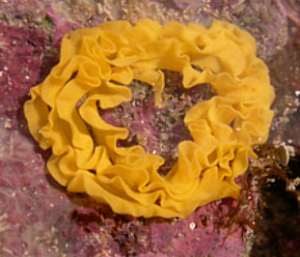
Hi Bill
Wandering along the Middle Beach rock platform recently, observing under loose rocks I came across two nudibranchs with egg masses - these nudibranchs are reasonably common intertidally, and I have often seen these size and colour egg masses but never matched the two. In the flesh they appear quite dark, the spotted appearance came up more in the photo. [Lord Howe Island, Tasman Sea]
Ian Hutton
lhitours@bigpond.com
Hutton, I., 2004 (Feb 25) Dendrodoris nigra & eggs from Lord Howe Is.. [Message in] Sea Slug Forum. Australian Museum, Sydney. Available from http://www.seaslugforum.net/find/12180Dear Ian,
This is Dendrodoris nigra
Bill Rudman
Dendrodoris nigra (?) from Mayotte
December 3, 2003
From: Marina Poddubetskaia
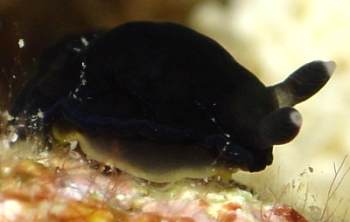
Dear Bill,
This completely black guy was found under a stone. I'm hesitating between Dendrodoris nigra and Dendrodoris fumata. But, according to its gills which seem to be gathered into a compact circle, I assume it is D. nigra. Could you confirm this ID, please.
Is the brown colour of the foot a distinctive future of this species ?
Date: November 07, 2003
Location : Mayotte Island, Indian Ocean
Site: Passe en S, buoy n° 2
Depth: 10m
Size: 12mm
Cheers,
Marina.
nembro@nembro.info
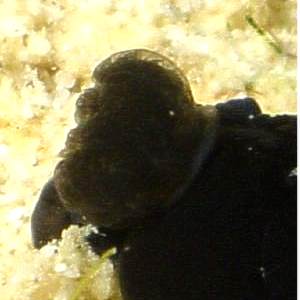
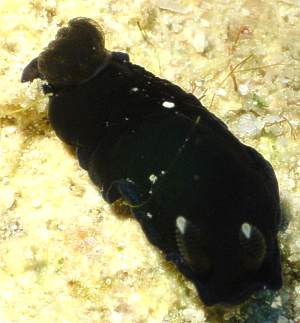
Dear Marina,
These dendrodoirds are a bit problematic, specially when I only have photos to go on but I am pretty sure it is D. nigra. The numerous gills arranged in a tight cluster is characteristic as is the position of the gills far to the posterior end of the body. The animal also appears to be quite elongate in shape rather than oval whhich is another character of D. nigra.
Concerning the brown edge to the foot. Many of these dark animals have a paler, less pigmented edge to the foot. As far as I know it is not a species character
Best wishes
Bill Rudman
Dendrodoris nigra - egg ribbon
March 20, 2003
From: Rachel Przeslawski
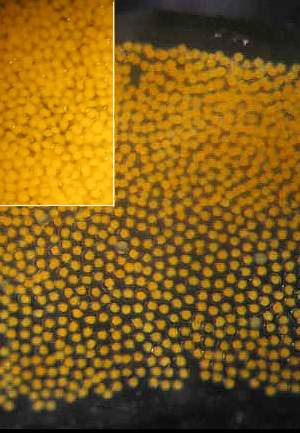
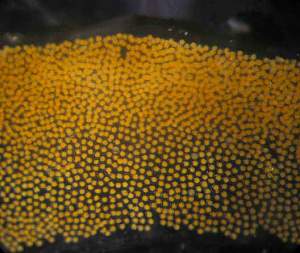
Hi Bill,
Here's the information on the Dendrodoris egg masses you asked about. Unfortunately the quality of some of the photos is low. One set is of Dendrodoris nigra and the other is of Dendrodoris fumata. The photos in this message are of D. nigra. [Note: inset in upper photo is of D. fumata for comparison]. The ones of D. fumata are in a separate message.
Both species laid in the laboratory and both laid thin upright spiral orange egg ribbons. D. nigra laid a looser "messier" spiral while D. fumata laid a neatly coiled mass. D. nigra had a wider egg ribbon (5.5-6mm) than D. fumata (3-5mm) although this is likely variable considering only 3 egg masses were examined. D. fumata had a much higher density of embryos very tightly packed while D. nigra [see inset] only had 2 layers of embryos in moderate density. D. nigra had larger eggs and capsules (125um, 175um ) than D. fumata (< 75um, 100um).
As with most nudibranch egg masses there was only 1 egg per capsule with occasional twins. I allowed both ribbons to hatch, and found that embryos hatched at swimming veliger stage in both. D. nigra had a very noticeable large bi-lobed velum.
Keep in mind these observations are only from 2 D. fumata and 1 D. nigra egg masses so further observations would be great to see potential variations within each species. You'll also be pleased to know that I've gotten access to a camera that has a better capacity for close-ups than the one I've been using. Hopefully you won't receive any more of these bad photos from me, but I thought it was better than nothing in this case!
Cheers
Rachel
rachelp@uow.edu.au
Przeslawski, R., 2003 (Mar 20) Dendrodoris nigra - egg ribbon. [Message in] Sea Slug Forum. Australian Museum, Sydney. Available from http://www.seaslugforum.net/find/9435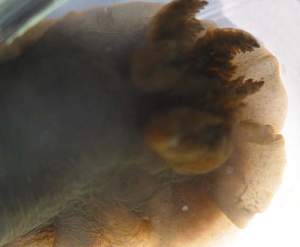
Thanks Rachel,
The cup-shaped arrangement of many gills in your photo would seem to confirm this is Dendrodoris nigra. I will be good to get some further photographed animals and their egg ribbons to confirm these differences.
Best wishes,
Bill Rudman
Unknown black sea slug in aquarium
February 16, 2003
From: Nate C.
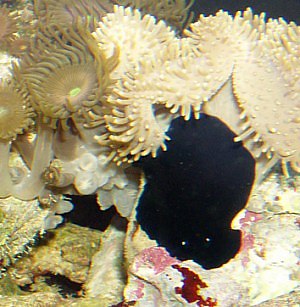
We have a 75 gallon reef tank that has been up and going for 5-6 months after a complete loss. Today for the first time, we noticed a black mass on the side of a newly bought (5 days ago) toadstool. After pushing on an edge, we noticed two white "eyes" on protruding antenni that retracted. It then began to move away from my proddings, and we realized it was some type of sea slug. I've managed to get a picture of it, didn't notice any prominent gills, but didn't see a hard shell under skin flaps either. It seems to be fairly round in shape, not elongated, and also is quite flat. The picture shows the protruding white spots toward the bottom of the slug. Anyone have any ideas? Also, any idea what it feeds on? We have all soft corals, a max. clam, anemones, brain corals (think these are soft...but just in case), and various fish/inverts.
Nate
canfienl@gte.net
Nate, 2003 (Feb 16) Unknown black sea slug in aquarium. [Message in] Sea Slug Forum. Australian Museum, Sydney. Available from http://www.seaslugforum.net/find/9224Dear Nate,
This is either Dendrodoris nigra or Dendrodoris fumata. There is no easy way to tell them apart on your photo. A quite good way of separating them, if you want to, is to look at the gills. In D. nigra there are 10 or more small gills arranged in a circle right at the posterior end of the body, while in D. fumata there are usually 5 large branched gills attached further forward. D. nigra seems to be the most common of the two in aquaria. I guess it arrived on some live rock with its sponge food. Possibly you are now seeing it because it is eaten all its food and is on the prowl for more - and before you ask, I'm sorry but I don't know just which sponge it eats or where you can get some.
Cheers,
Bill Rudman
Dendrodoris nigra - hitchhiking again
February 4, 2003
From: Jeff Lord
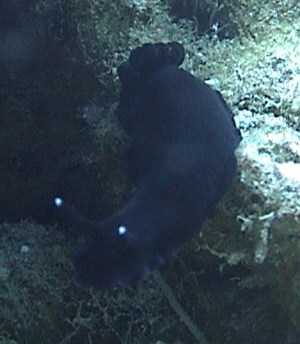
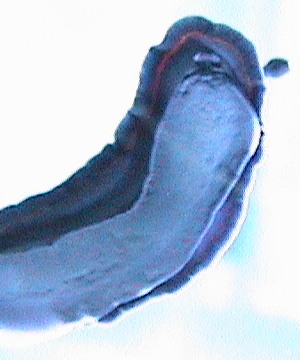
Dear Dr. Rudman,
I guess the answer to my question is that this creature is Dendrodoris nigra. I set up a 100 gallon reef tank with 140 pounds of Fiji live rock. My guess is that this fellow came along for the ride with these rocks. Looking at its solid black color, with only white tipped rhinophores and the red border visible around its mantle makes me think that it is young. This nudibranch emerged after having the tank set up for two months - It made its debut in my tank three days ago, and I remembered your site. I read that this animal only eats sponges. Do these creatures ever eat algae? I have been watching it forage in areas on the glass where some algae is prevalent. (maybe sponge colonies are proliferating in the corners of my tank.)? Do you have anything I should know about keeping this creature (or not) in a reef tank...
Thank you,
Jeff Lord
JeffL7849@aol.com
Lord, J., 2003 (Feb 4) Dendrodoris nigra - hitchhiking again. [Message in] Sea Slug Forum. Australian Museum, Sydney. Available from http://www.seaslugforum.net/find/9034Dear Jeff,
It's nice when questions are self-answered. Yes it's D. nigra. Concerning its feeding. I'm afraid that just as lions can't survive on grass when the meat runs out, Dendrodoris will needs some of its particular sponges to survive. I'm afraid I can't help on this. I suspect it has been surviviung on a sponge colony in some crevice in your live rock which may now be at an end. I guess you coud try some more live rock, on the off-chance it will have the right sponge, but basically unless you know the food and have a ready supply of it, nudibranchs are not a good idea in aquaria.
Best wishes,
Bill Rudman
Dendrodoris nigra from Lord Howe Island
January 27, 2003
From: W.B. Rudman
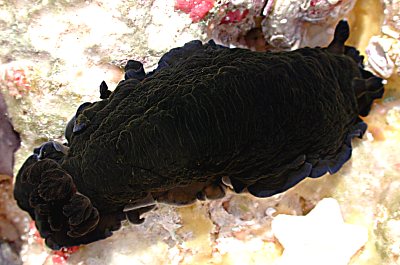
Here is a photo record from Ian Hutton of Dendrodoris nigra from Lord Howe Island.
Location: Neds Beach.
Bill Rudman
Rudman, W.B., 2003 (Jan 27) Dendrodoris nigra from Lord Howe Island. [Message in] Sea Slug Forum. Australian Museum, Sydney. Available from http://www.seaslugforum.net/find/8951Solid black nudibranch in aquarium
December 18, 2002
From: Jennie
A solid black nudibranch has appeared in my aquarium and I'm hoping to get an ID or basic information on it. I think it is a dorid nudibranch because it has feathery plumes in a circle on the rear end. It has two eyestalks that have a white dot on the tip, otherwise it is solid black. It is about 2-3 in. long.
Any idea?
Jennie
jennie_yoder@yahoo.com
Dear Jennie,
Certainly sounds like a dorid nudibranch, and the most likely suspect is Dendrodoris nigra. Have a look at the photos and messages on that page, and the very similar Dendrodoris fumata to get an idea of colour variation in the two species. D. nigra is found throughout the Indo-West Pacific and from queries to the Forum it seems to survive quite happily in 'live rock' which is collected and sold to the aquarium trade. I presume it is feeding on small crevice-dwelling sponge colonies also on the live rock. It will survive and grow for as long as the appropriate sponge colony survives. I don't know what sponges it eats and I suspect that even if I did, there is no way the aquarium trade has the knowledge to obtain the correct species for you on demand.
Best wishes,
Bill Rudman
Black Slug? in aquarium
December 7, 2002
From: Durwin Gin
I spotted a black blob in the crevice of one of my live rocks soon after the lights came on. A few moments later, I came back to find that it had moved and was crawling around on the sand and rocks (looking for cover, I believe). It was all black, had two antennae in front that pointed up, the sides rippled a bit, and it had a ball-like thing near the rear (the ball looked like a closed flower bulb). It was about 3" long and almost 1" wide. Any ideas?
Durwin Gin
durwingin@yahoo.com
Dear Durwin,
It always helps if you can give me some idea in the world where your mystery may have come from. From your description, it is most likely to be a dorid nudibranch called Dendrodoris nigra. If I am right, the 'flower bulb' would be its gills. Dendrodoris nigra could have arrived on a piece of 'live rock' which may have had the right food sponge growing in a crevice. I can't imagine it doing any damage in your aquarium but I'm afraid its chances of survival aren't good once it runs out of its favourite sponge
Best wishes,
Bill Rudman
Red form of Dendrodoris nigra
June 10, 2002
From: Valda Fraser

Dear Bill
My friend Martin Wallace drew my attention to a nudibranch that I'm not familiar with while diving recently! Can you help with identification?
Locality: Pumula, south coast KwaZulu-Natal, 28 m, South Africa
Date: May 2002
Size: 30mm
Thanks.
Regards
Valda Fraser
valdafraser@mweb.co.za
Fraser, V., 2002 (Jun 10) Red form of Dendrodoris nigra. [Message in] Sea Slug Forum. Australian Museum, Sydney. Available from http://www.seaslugforum.net/find/7086Dear Valda,
This is a very red colour form of Dendrodoris nigra. Usually the red colour form is only found in small juveniles, but sometimes very large animals stay red.
Best wishes,
Bill Rudman
Dendrodoris nigra from Christmas Island
May 16, 2002
From: W.B. Rudman

Here is a photo of Dendrodoris nigra from John Hicks' Christmas Island, Indian Ocean collections. The photo shows a pair of animals changing from a juvenile pink colour form to black.
PHOTO: AM C127473, Christmas Is., Indian Ocean. The larger of these two specimens was 8 mm long alive. Photo: John Hicks
Best wishes,
Bill Rudman
Dendrodoris nigra from Philippines
June 14, 2001
From: Jeff Rosenfeld
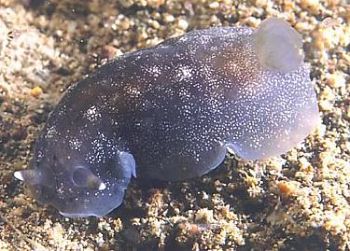
Hi Bill,
Here's another shot taken in Anilao, Luzon Island, Philippines in April, 2000 that we I assume is Doriopsis pecten. Can you provide any info about the species?
Thanks!
Jeff
jhrosenfeld@seattleschools.org
Rosenfeld, J., 2001 (Jun 14) Dendrodoris nigra from Philippines. [Message in] Sea Slug Forum. Australian Museum, Sydney. Available from http://www.seaslugforum.net/find/4576Dear Jeff,
This is one of the many colour forms of Dendrodoris nigra. One way to identify species of Doriopsis is that their gills are arranged in a row across the mantle rather than in a circle. In fact the name pecten means comb in Latin, which is a reference to the comb-like arrangement of the gills. I just looked at the Doriopsis pecten Page and see that I promised to put some photos and information on that species up a year or more ago - how embarrassing! Now that I have been found out it looks like I will have to so something about it.
Best wishes,
Bill Rudman
Re: Solid Black Nudibranch
April 13, 2001
From: Nathan Paden
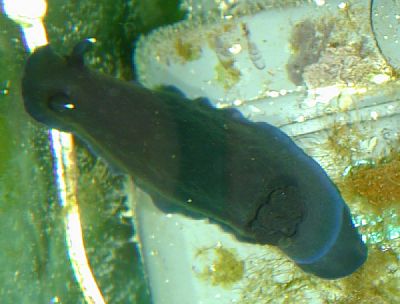
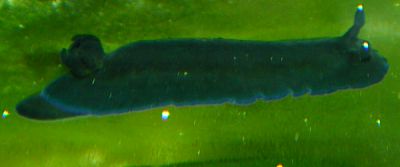
Bill,
I got some pics of the nudibranch last night! On closer inspection I think it is a Dendrodoris nigra. However it's mantle still doesn't appear as pronounced as the pics on your site and it is solid black with only the tips of the rhinophores with any white at all.
The bluish purple color around the edge was not a result of the camera. I could plainly see that color with my eyes. The question would be whether the lighting in my aquarium could have caused that color
Nathan
npaden@bsgm.com
Paden, N., 2001 (Apr 13) Re: Solid Black Nudibranch . [Message in] Sea Slug Forum. Australian Museum, Sydney. Available from http://www.seaslugforum.net/find/4181Dear Nathan,
The photos make it much easier. Yes it is Dendrodoris nigra. When crawling along the mantle 'skirt' tends to be folded down against the sides of the body so it doesn't look as wide and 'frilly' as in some of the photos on the site. The blue edge is a bit unusual, but a bluish sheen is often present around the mantle margin and on other parts of the body. As you mention, it is usually only visible in certain lights.
Species of Dendrodoris are able to squeeze into very narrow cracks and crevices so I ma not sure how big your animal would have been when you got your last 'live rock'. Whatever its size, it seems to have found a supply of one of the sponges it feeds on in your aquarium, which is certainly stroke of luck for it (and you).
Best wishes,
Bill Rudman
Solid Black Nudibranch
April 11, 2001
From: Nathan Paden
Last night I discovered a black nudibranch in my reef tank. It very closely resembles the body type of the Risbecia tryoni nudibranch. It's rhinophores are tipped in white but the remainder of the nudibranch is solid black. I reviewed your site extensively looking for possibliities and the Dendrodoris nigra and Dendrodoris fumata do not appear to be viable candidates. Their body shape is not right and my nudibranch does not have a flowing mantle at all.
My nudibranch must be finding something to eat as the last live rock addition to my tank was some Vanasi rock several months ago. Other additions could be Fiji rock over a year ago. I do have several species of sponges that could possibly be a food source for the nudibranch. The size of the nudibranch was approx. 5 cm long and 1.5 cm wide. At first I thought it was a large suction cup that had somehow been melted into a funny shape or something! :-)
I tried to get a picture of it, however it was in the back corner of the tank and I couldn't get my camera to focus on it. I will continue to try to get a photo of it.
I would appreciate any thoughts on this. I am fairly confident in the body shape similarity with the Risbecia tryoni especially the shape of the head and the lack of a flowing mantle as shown in the Dendrodoris sp.
Thanks,
Nathan
npaden@llano.net
Paden, N., 2001 (Apr 11) Solid Black Nudibranch . [Message in] Sea Slug Forum. Australian Museum, Sydney. Available from http://www.seaslugforum.net/find/4134Dear Nathan,
Tha white-tipped rhinophores sound like Dendrodoris nigra but you don't mention anything about gills which makes me wonder if you have a nudibranch at all. If you have, it is extremely lucky, having arrived in your aquarium either with some live rock that had the right sponge food living on it, or it has found the right sponge already living in your aquarium.
The other possibility is that you have a 'slug-like' snail such as Scutus which travels well on 'live rock', is black, and feeds on algae. One easy way to tell is to gently poke its back and see if it has a white shell which is usually hidden underneath black skin flaps. Have a look at the Scutus page for some photos. The other thing ito look for are the position of the 'rhinophores'? Are they under the mantle skirt or do they emerge from pockets on the back?
Basically its hard to be sure what you have without an illustration. If it won't cooperate for a photo, could you manage a rough drawing or two which you could scan and send me?
Best wishes,
Bill Rudman
Dendrodoris nigra from Saudi Arabia
February 6, 2001
From: Gordon T. Smith


Dear Bill,
Well I have just scanned 40 slides to send to you and the identification begins with this one. It was approximately 2.5 cm long at a depth of 5 metres. Is it Dendrodoris nigra. Photographed in Sharm Obhur (The Creek) north of Jeddah, Saudi Arabia.
Regards
Gordon
aquashot@emirates.net.ae
Smith, G.T., 2001 (Feb 6) Dendrodoris nigra from Saudi Arabia. [Message in] Sea Slug Forum. Australian Museum, Sydney. Available from http://www.seaslugforum.net/find/3639Dear Gordon,
Yes this is D. nigra. The patches of white spots, when present, and the placing of the many gills far back on the body are both characteristics of this species.
Best wishes,
Bill Rudman
Dendrodoris nigra feeding
January 9, 2001
From: Chris Benson
I found a Dendrodoris nigra nudibranch in my reef tank (thanks to the SSF I was able to make the ID). What do these guys eat?
Also, would there be any problem putting it into a tank with a small octopus?
Thanks,
Chris
crbenson1@rcn.com
Benson, C., 2001 (Jan 9) Dendrodoris nigra feeding. [Message in] Sea Slug Forum. Australian Museum, Sydney. Available from http://www.seaslugforum.net/find/3495Dear Chris,
Have a look at my reply to JK's message which arrived about 3 seconds before yours. Concerning co-existence with an Octopus. I wouldn't like to say. Most Octopuses love to eat snails, many drilling a hole through their shell to get in. I can't say if they eat nudibranchs, as there are no inedible remains to be left as evidence. If the worst happens you could always let us know and I can put it on the Sea Slug Predators List.
Best wishes,
Bill Rudman
Dendrodoris nigra feeding
January 9, 2001
From: J. Kennedy
Greetings,
Found the Dendrodoris nigra in my aquarium, so cool. But was wondering what it eats. I'd like it to be able to survive in my tank.
Thanks for your help,
JK
Jkennedy@apple.com
Kennedy, J., 2001 (Jan 9) Dendrodoris nigra feeding. [Message in] Sea Slug Forum. Australian Museum, Sydney. Available from http://www.seaslugforum.net/find/3496Dear JK,
When you say 'found' in your aquarium I guess that means it just appeared one day. If so, it has probably found something to eat in your aquarium. Can you give me some idea of its size? Species of Dendrodoris feed on sponges, D. nigra has been reported to feed on Halichondria dura Lindgren but most sponges are difficult to identify and difficult to keep in aquaria. If you are lucky you have a sponge which Dendrodoris eats and which can survive in you aquarium. If I were you I would just keep my fingers crossed that the sponge grows faster than Dendrodoris feeds.
Best wishes,
Bill Rudman.
Thanks For Help
December 29, 2000
From: Chris Stephens
Many thanks for the help received in finding an id for my slug, from the suggestions you gave it is a match for Dendrodoris nigra.
Great job, thats one more life form identified.
Cheers and a happy new year!
Chris
chris@chrisreef.co.uk
Stephens, C., 2000 (Dec 29) Thanks For Help. [Message in] Sea Slug Forum. Australian Museum, Sydney. Available from http://www.seaslugforum.net/find/3452Help to id slug
December 28, 2000
From: Chris Stephens
I'm trying to find an id for a nudibranch which has mysteriously appeared in my 120 gallon reef tank, it must have come in with some rock. The original live rock was added back in October and the last addition, a Sarcophyton, was made a few weeks ago so I'm quite surprised we haven't seen it before.
Alas, I didn't have the digi cam at the time and it hasn't been since it's brief appearance yesterday. It is about 1.25 inches long, jet black except for the white tips to it's eye stalks (?) and it had a translucent underside. It's body was completely smooth apart from the eye stalks and the bump at the back. I know it's not much to go on but any suggestions would be appreciated, I'll keep the camera ready for it's next appearance.
I'm aware that they do not fare well in captivity and I would never purposely do anything to remove them from their natural environment, but now I have it it would be great to id it.
Many thanks,
Chris Stephens
chris@chrisreef.co.uk
Stephens, C., 2000 (Dec 28) Help to id slug. [Message in] Sea Slug Forum. Australian Museum, Sydney. Available from http://www.seaslugforum.net/find/3448Dear Chris,
It's a bit hard to identify your animal from your description but here are three possibilities.
If it definitely is a slug, that is there is no shell and what you call 'eyestalks' are really rhinophores, then the most likely animal you have is Dendrodoris nigra or Dendrodoris fumata. These species both have colour forms which can be completely black except for white tips to the rhinophores. Another thing to check is whether they have a circle of gills on their back.
If you get a chance to touch your mystery animal on the back you may find that it has two black flaps which cover a snail shell. Your mention of the soft coral Sarcophyton suggests the egg cowry Ovula ovum. I don't have a photo of it handy but have a look at the page on ovulids for some background information.
My third suggestion would be Scutus, another snail with a hidden shell, which you see from the correspondence is a common hitch-hiker on 'live rock'.
I can't say much more until you can photograph your animal, or prod it to see if is has a shell or not. [I am not sure how familiar you are with we pages, but if you click on any of the words I have underlined it will take you to a relevant page].
Best wishes,
Bill Rudman.
Another Samoan nudibranch
August 29, 2000
From: Don Barclay

Hi Again, Bill,
This brown-mottled nudibranch was found near the Glossodoris in 17 meters of water, also under a rock, east of Fagamalo village on the northwest side of Tutuila, American Samoa. Collected 3 pm local time, 26 August 2000. This one was also approximately 20mm when it was crawling.
The rhinophores look fairly distinctive, with a "ball" of reddish orange near the ends, a black or dark purple ring just on top of the ball, and a white tip. Can you ID it for us?
Thanks again,
Don
n5ols@samoatelco.com
Barclay, D., 2000 (Aug 29) Another Samoan nudibranch. [Message in] Sea Slug Forum. Australian Museum, Sydney. Available from http://www.seaslugforum.net/find/2940Dear Don,
I am pretty sure this is a colour form of the very variable Dendrodoris nigra. The rhinophores are quite distinctive, and in juveniles they often have this red and black banding. Have a look at photos I, F, above which show animals with the same coloured rhinophores.
It looks to me as though this could be a coastal colour form. Was this from an area with much silt in the water or near a river mouth?
Best wishes,
Bill Rudman.
Note added 31 August 2000: See Don's reply saying that the water at this site is always exceptionally clear.
Rudman, W.B., 2000 (Aug 29). Comment on Another Samoan nudibranch by Don Barclay. [Message in] Sea Slug Forum. Australian Museum, Sydney. Available from http://www.seaslugforum.net/find/2940Dendrodoris nigra from Sulawesi
July 25, 2000
From: Lindsay Warren
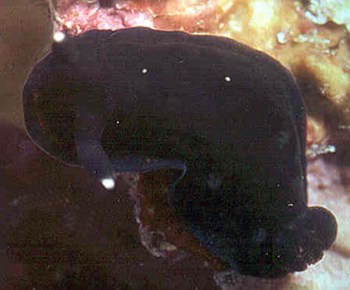
Dear Bill
This Dendrodoris was found by Guillermo Moreno on 18 October 1999 at a
depth of 37 ft on coral rubble and filamentous algae in a sheltered spot on Pulau Hoga [Tukang Besi Archipelago, SE Sulawesi, Indonesia - Operation
Wallacea]. Size: 10 mm.
It was completely black except for the white tips on the lamellate rhinophores and three white specks on one side of the notum. The edge of the mantle seemed to curl up on itself to a small extent (rather like Hexabranchus
sanguineus) and at the anterior end was a band of "speckled, glittery dark
orange / burgundy" which was clearer when its head was facing up towards one. The branchial plume is set way back on the notum. There was a hint of 'orange glitter' on the upper surface of the foot. Down the notum was a 'humped' central area. Photo: Lindsay Warren
Are we right in thinking it is Dendrodoris nigra?
All the best
Lindsay
alldcl@compuserve.com
Warren, L., 2000 (Jul 25) Dendrodoris nigra from Sulawesi. [Message in] Sea Slug Forum. Australian Museum, Sydney. Available from http://www.seaslugforum.net/find/2740Dear Lindsay,
Yes you are right in thinking it is D. nigra. The cluster of small gills set quite a way back on the mantle is quite a good character separating it from Dendrodoris fumata.
The traces of a submarginal red-orange band around the anterior end of the mantle [see inset] is interesting. When it was smaller it probably has quite a spectacular submarginal red band all around the mantle edge. Only some specimens have this band, and those that do usually gradually lose it as the animal grows. A range of colour forms can be seen at the top of the page.
Best wishes,
Bill Rudman.
Dendrodoris nigra from South Africa
July 8, 2000
From: Valda Fraser
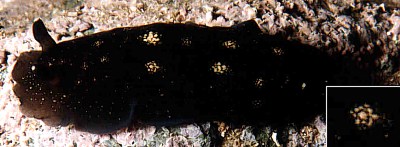
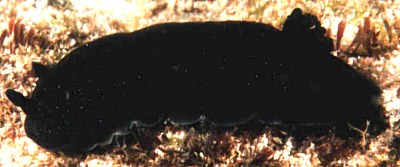
Dear Bill
Please tell me if you agree with me in suggesting that this is Dendrodoris nigra. I have sent 2 photos to illustrate colour variation.
Locality: Mpande, Transkei, SOUTH AFRICA - intertidal zone
Date: June 2000
Size: 48mm
Thanks.
Regards
Valda
iti04937@mweb.co.za
Fraser, V., 2000 (Jul 8) Dendrodoris nigra from South Africa. [Message in] Sea Slug Forum. Australian Museum, Sydney. Available from http://www.seaslugforum.net/find/2666Dear Valda,
yes these both seem to be D. nigra. One good way to separate it from the similarly coloured Dendrodoris fumata is that D. fumata has a few (usually 5) large gills which sit out in a big circlet covering the posterior end of the mantle while D. nigra has a tight upright circle of many (10 or more) gills.
Your upper photo shows a colour form which seems more common in the western Indian ocean than in the Pacific in which some of the white epithelial glands are arranged in clusters, with one gland in the middle surrounded by a ring of glands (see inset). This was a common form in Tanzania, when I was there in the 1970s.
Best wishes,
Bill Rudman.
Black nudibranch
April 10, 2000
From: Eric Jensen
I found a nudibranch that is either solid black or dark, dark blue with white tips on his antenna. It is about 2-1/2" long. Any idea what it is?
eric jensen
ericj25@msn.com
Jensen, E., 2000 (Apr 10) Black nudibranch. [Message in] Sea Slug Forum. Australian Museum, Sydney. Available from http://www.seaslugforum.net/find/2243Dear Eric,
It would be useful to know where in the world you saw this black nudibranch. Nudibranchs, like most animals, each have their own geographic range. It is most unlikely that an animal you found in the Mediterranean would also live in say, the west coast of North America. So if I knew where you found your animal I would have a much better idea of what you most likely saw.
While waiting for your reply, I could guess at Dendrodoris nigra or Dendrodoris fumata which both have colour forms which are essentially black with white tipped rhinophores (head tentacles). They are both found in the tropical and subtropical Indian and western Pacific Oceans. Have a look at the pages in the Forum on those two species (by clicking on the names) and see if they look like your animal.
Best wishes,
Bill Rudman.
Dendrodoris nigra
January 28, 2000
From: katabyss
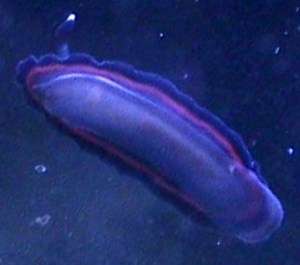
Just wanted to know about this lil guy.. what his name is, any help would be great!
catabyss@hotmail.com
This is almost certainly Dendrodoris nigra, which you will see from the pictures is very variable in colour. I tried to email you for more details but your email address rejects my messages. I would appreciate some details about where your animal comes from and its size ... and what would you like to know about it?
Best wishes,
Bill Rudman.
Pages on Dendrodoris nigra & D. fumata
August 19, 1999
From: Bill Rudman.
Here at last are pages on two of the most common intertidal dorids in the Indo-West Pacific, Dendrodoris nigra and Dendrodoris fumata .
While some of the extensive colour variation is based on age, animals changing colour as they grow, much is also genetic or environmental.
Bill Rudman.
